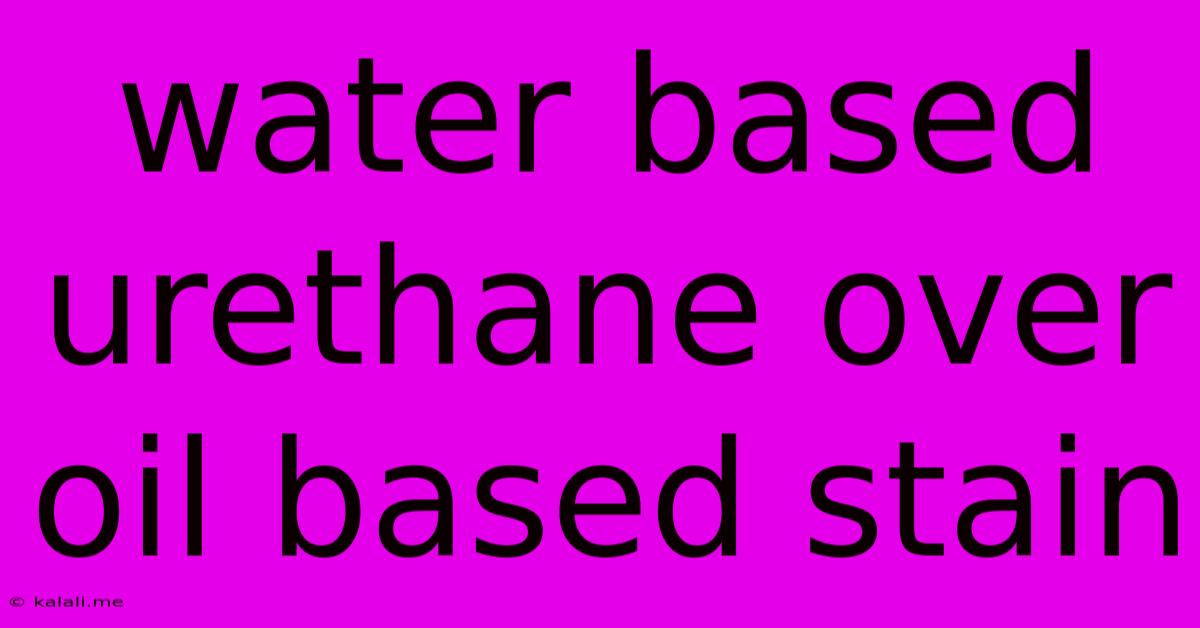Water Based Urethane Over Oil Based Stain
Kalali
Jun 06, 2025 · 4 min read

Table of Contents
Can You Use Water-Based Polyurethane Over Oil-Based Stain? A Comprehensive Guide
Meta Description: Wondering if you can apply water-based polyurethane over oil-based stain? This guide explores the compatibility, preparation steps, and potential problems, offering expert advice for a successful finish. Learn about drying times, adhesion issues, and best practices for a long-lasting, beautiful result.
Applying a protective topcoat over your stained wood is crucial for durability and longevity. But what happens when you've chosen an oil-based stain and now want to use a water-based polyurethane? The question of compatibility often arises, prompting concerns about adhesion and the final finish. This article will delve into the intricacies of using water-based polyurethane over oil-based stain, providing a clear understanding of the process and potential challenges.
Understanding the Chemistry: Oil vs. Water-Based Products
Before diving into application techniques, it's crucial to understand the fundamental differences between oil-based and water-based products. Oil-based stains penetrate deeply into the wood grain, creating a rich, long-lasting color. They are known for their durability and ability to enhance the natural beauty of the wood. However, they require longer drying times and often have strong solvents, posing environmental and health concerns.
Water-based stains, on the other hand, are less penetrating and tend to sit more on the surface of the wood. They offer faster drying times, are easier to clean up with water, and are generally considered more environmentally friendly. Water-based polyurethanes share similar characteristics: quick drying, easy cleanup, and lower VOC emissions.
The Compatibility Issue: Can it be done?
The short answer is: yes, but with careful preparation. The primary concern is the compatibility between the oil-based stain and the water-based polyurethane. Water-based polyurethane cures by evaporation, and if the oil-based stain isn't fully cured, the polyurethane might not adhere properly. This can lead to peeling, bubbling, or a less durable finish.
Essential Preparation Steps for Success
Achieving a successful finish requires meticulous preparation. Here's a step-by-step guide:
-
Ensure Complete Curing: Allow the oil-based stain to cure completely. This typically takes several days, or even weeks, depending on the stain, the wood type, and environmental conditions like temperature and humidity. Thoroughly check the manufacturer's instructions for the specific curing time.
-
Clean the Surface: Remove any dust, debris, or excess stain from the surface. A tack cloth is highly recommended for this.
-
Light Sanding (Optional): Lightly sand the stained surface with fine-grit sandpaper (220-grit or higher). This helps create a slightly rough surface for better adhesion. Be gentle to avoid removing the stain.
-
De-glossing: Use a tack cloth to remove any sanding dust. This is critical to ensure a smooth, flawless finish.
Applying the Water-Based Polyurethane
Once the surface is properly prepared, you can apply the water-based polyurethane.
-
Thin Coats: Apply thin, even coats of polyurethane. Multiple thin coats are far superior to one thick coat, which is more prone to running and imperfections.
-
Proper Technique: Use a high-quality brush, roller, or sprayer, applying the polyurethane in the direction of the wood grain.
-
Drying Time: Allow each coat to dry completely before applying the next. Check the manufacturer's instructions for the recommended drying time between coats. This usually ranges from 2-4 hours.
-
Light Sanding Between Coats (Optional): Very lightly sand between coats with fine-grit sandpaper (320-grit or higher) to smooth out any imperfections. Again, use a tack cloth to remove all dust before applying the next coat.
Potential Problems and Solutions
-
Poor Adhesion: If the oil-based stain wasn't fully cured, or the surface wasn't properly cleaned, the polyurethane may not adhere properly. This can result in peeling or bubbling. In this case, you may need to remove the polyurethane and reapply after allowing the stain to cure longer.
-
Blistering: Blistering can occur if the polyurethane is applied too thickly or if there's moisture trapped beneath. Thin coats and proper drying time are crucial to prevent this.
-
Uneven Finish: Uneven coats can result from improper application techniques or insufficient drying time between coats.
By following these guidelines and paying close attention to the preparation and application process, you can successfully apply water-based polyurethane over oil-based stain, achieving a beautiful and durable finish for your woodworking project. Remember to always consult the manufacturer's instructions for your specific products for the most accurate guidance.
Latest Posts
Latest Posts
-
Sorry For Your Loss Or Lost
Jun 06, 2025
-
How Do I Remove Silicone Caulk
Jun 06, 2025
-
Why Does My Screen Turn Black On Markup
Jun 06, 2025
-
Do I Need 2 Electrical Panel Ground Rods In Indiana
Jun 06, 2025
-
How To Auto Capital Letter Sharepoint List Column
Jun 06, 2025
Related Post
Thank you for visiting our website which covers about Water Based Urethane Over Oil Based Stain . We hope the information provided has been useful to you. Feel free to contact us if you have any questions or need further assistance. See you next time and don't miss to bookmark.